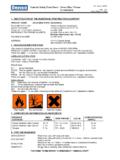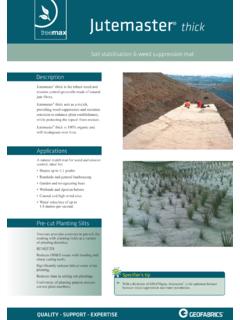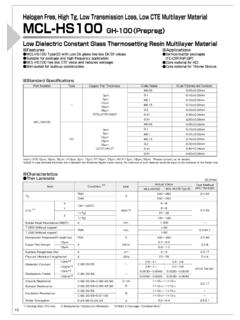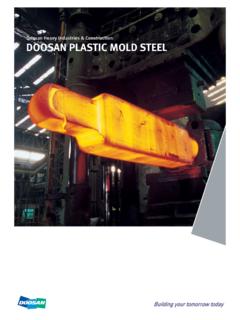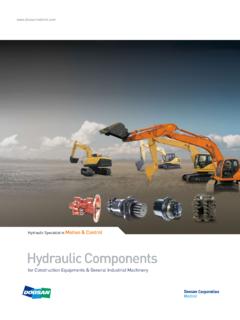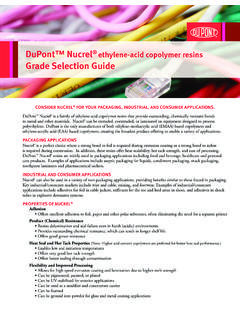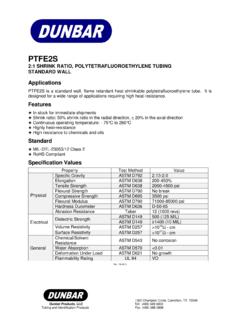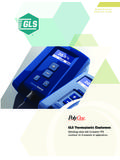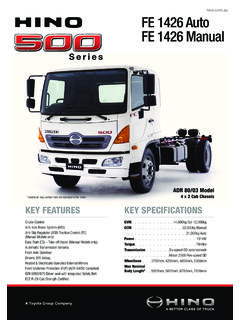Transcription of Concrete pipe manual - GEOTAS
1 Concrete Pipes BUILD ON OUR EXPERTISEA. Introduction .. 2B. Test Load Data .. 6C. Concrete Culvert Pipes .. 7 Flush Joint .. 7D. Concrete Stormwater Pipes .. 14 Rubber Ring Joint .. 14 Rubber Ring In-wall Joint .. 16E. Concrete Sewerage Pipes .. 20F. Concrete Pressure Pipes .. 25 Standard Class Range .. 27G. Concrete Irrigation Pipes .. 33 Imperial and Metric Equivalents .. 35H. Concrete Jacking Pipes .. 36J. Handling and Installation .. 40 Index .. 47 pipe Design Request Sheet .. 48 CONTENTS1 General Humes Pty Limited is the leading manufacturer of steel rein-forced Concrete pipes and associated precast products in in a wide range of diameters, lengths and with varying strengths, Humes Concrete pipes have a proven track record and are custom designed for users applications including drain-age, sewage, water supply and Pipes provides the information necessary to specify Humes Concrete pipes for all of these applications in the one easy-to-use of Humes Concrete pipes has also beensimplified with the inclusion of a pipe Design Request Sheet on page 48 of Concrete Pipes.
2 Please copy the sheet and complete the neces-sary information, then fax or mail to your nearest Humes office for the fastest possible Humes steel reinforced Concrete pipes are made from coarse and fine aggregates, cement and hard drawn deformed steel are manufactured and factory tested for quality to Australian Standard AS 4058-1992 "Precast Concrete pipes (pres-sure and non-pressure)". Pipes can also be custom made and tested to meet specific customer Humes Concrete pipes up to 2100mm nominal diameter (DN2100) are centrifugally cast using the Humespun process invented in 1910 in Australia by Walter Hume. In use throughout the world, the Humespun process of centrifugal casting produces strong and durable Concrete pipes. Humes Concrete pipes larger than DN2100 arevertically cast in steel moulds using high frequency vibration which produces Concrete pipes with characteristics compatible with those of centrifugally spun ideal pipe material for, handling peak flows, highabra-sion resistance and impermeability of Concrete makes steel reinforced Concrete pipe the most appropriateselection for specifying pipes whilst a range of natural characteristics further enhance its performance.
3 These include an indefinite increase in strength in the presence of moisture and autogenous healing of Types Humes Concrete pipes are manufactured with two basic joint types - Flush Joint and Rubber Ring Joint in pipes provide an interlocking joint and allows for a small degree of flexibility in the pipeline alignment. Rubber Ring Joint in pipes, either belled socket or in-wall joint depending on the diameter of the pipe and its application, are designed to accommodate change in pipeline alignment and settlement in a pipeline while maintaining a watertight information on the joints specific to pipe application types is provided in each of the following INTRODUCTION2 DurabilityFor most common installations, the service life of Concrete pipe is virtually unlimited. The longevity of steel reinforced Concrete pipe provides Asset Managers with a resource having low main-tenance in service and the ability to recycle into other projects when exhumed. Some of the Roman aqueducts are still in use after 2000 years and samples from the first known Concrete pipes in the US, laid in 1842, showed it to be in excellent condi-tion after more than 140 the 350 million kilometres plus of reinforced Concrete pipe that has been laid in Australia, the number of pipelines which have suffered from durability problems has been extremely small and confined mainly to unprotected pipe being used in aggressive in technology and processes such as the use of Humes Plastiline for sewer pipes and astringent inhouse quality control systems ensures Concrete will continue to be the most durable material for manufacture of centrifugally spun manufactured in 1920 at Loveday have been exhumed and reused in a culvert at the Gurra Road Project in in Class Humes steel reinforced Concrete pipes are available in Standard- strength (Class 2-4) and Super- strength (Class 6-10)
4 Load numeric classification system adopted to identify the load carrying capacity of Concrete pipes is based on any particular pipe class being able to carry approximately the same propor-tionate height of fill. Thus a Class 10 pipe can carry five times the height of fill of a Class 2 pipe in any size, under the same installation Section B: Test Load Data for further information on the range and test required strength of a Concrete pipe depends on both the load to be carried by the installed pipe and the supporting ground installation conditions. The load transmitted onto the pipe depends on the height and type of fill material. Also, when installed in a trench, the width of the trench at the top of the pipe is important. Generally the wider the trench, the greater the load for any height of fill over the load class for Concrete pipes can be determined by con-sulting the Australian Standard AS3725-1989 "Loads on Buried Concrete Pipes" which provides methods for determining the installed load on Concrete pipes from the earth fill over the pipes as well as any induced live (vehicle) load standard also provides a range of recommended Bedding Support Type installations.
5 The range varies from no support to haunch support to haunch and side the majority of pipe installations, Humes Standard- strength (Class 2-4) Concrete pipes, used inconjunction with type H2 or type HS2 Bedding Support, are suitable (see Figure A1).The letter 'H' in the terminology indicates haunch support only. 'HS' indicates both haunch and side support. The numerals after 'H' and 'HS' indicate the level of support in the material Tables A1 & A2 for Bedding Type H2 and HS2 are pro-vided for ease of specifying Concrete pipes within a limited range of stated conditions. Figure A2 compares the results for a sample pipe installation using both Type H and Type HS Bedding Supports. Similarly, for embankment installation, Table A5 is A1, Type H2 and Type HS2 Bedding SupportsWhere specified, compaction to be 60% Density Index or 90% max. Dry density for standard com-Table A1, Maximum Fill Height (m) & Installation Quantities ( ) for Bedding Type H2 for Trench Installation, Clayey Sand SoilNote : Installation quantities based on assumption of 10% bulking.
6 225 300 375 450 525 600 675 750 >25m 825 900 1050 1200 1350 1500 1650 1800 1950 2100 ClassInstallationQuantitiesSizeClass(DN) 2346810 Bed HaunchOverlayTrenchWidth (m)Size Class (DN) Humes standard range of Concrete pipes are available in diam-eters from 225mm (DN225) up to 2100mm (DN2100).Diameters outside this standard range and up to DN3600 are also available.
7 Special project pipes are also available for all sizes when required or where specified. Humes Concrete pipes are typically manufactured in nominal lengths to optimise transport and handling. Other lengths, longer or shorter can be manufactured on tables listing the availability of Size Classes (DN) are provided in each testing of pipes to validate Load Class A2, Maximum Fill Height (m) & Installation Quantities ( ) for Bedding Type HS2 for Trench Installation, Clayey Sand SoilNote : Installation quantities based on assumption of 10% bulking. 225 300 375 450 525 600 675 750 >25m 825 900 1050 1200 1350 1500 1650 1800 1950 2100 (DN)Load ClassInstallationQuantities23468 SideSupportBed HaunchOverlayTrenchWidth (m)In large fill situations, a combination of Standard- strength Concrete pipes and Type HS3 Bedding Support* canprovide the most appropriate solution.
8 Table A3 provides details for such an installation.*Type HS3 Bedding Support is similar to that required by a flex-ible pipe A3, Maximum Fill Height (m), Embankment Conditions (p= ), Bedding Type HS3, Clayey Sand Soil* Width for Quantities as for HS2, Table A2 225 - 300 450 600 750 900 1050 1200 1350 1500 1650 1800 1950 2100 (DN)Load Class2346 Figure A2, Comparative Fill Heights of Standard- strength Concrete PipesTypical Fill Heights for any pipe size class and load classBedding prepared, pipes laid ready to receive back establish the flow rates for the various types of Concrete pipes, Manning's formula should be used for short run culvert and drainage applications, while the Colebrook-White formula should be used for long run drainage, gravity sewer lines and all pressure pipe Concrete pipe Association of Australasia publication "Hydraulics of Precast Concrete Conduits" details on the hydraulics for the different pipe types are provided in each Concrete pipe for varied uses is made simpler with the advent of computer design application Technical (Design)
9 Services have a range of programs suitable for most designer purposes which can be used to evaluate pipe performance and allows the designer to investigate various con-crete pipeline alternatives, including pipe selection, installation specification and pipeline hydraulics. Further information on services available and details on the programs can be obtained by contacting your local Humes A5, Max. Fill Heights (m), Embankment Conditions, Bedding Support Types H2 (p= ) & HS2 (p= ), Clayey Sand Soil 225 - - - - - - 300 375 450 525 600 675 750 825 900 1050 1200 1350 1500 1650 1800
10 1950 2100 ClassSizeClass(DN)H2HS22346810H2HS2H2HS2 H2HS2H2HS2H2HS2 Table A4 presents Induced Trench conditions for a limited range of pipes combined with type HS2 Bedding Support and indi-cates the advantages (see Figure A3 also).In all cases, the most appropriate installation can be obtained by matching pipe Load Class and the Bedding Support Type. The maximum effect of varying the Bedding Support Type is that the required strength of a pipe can be reduced to as much as one quarter of the calculated inservice allows the designer to choose the most economic combi-nation of pipe strength and pipe Concrete pipe Association of Australasia software " Concrete pipe Selector, Version " is A4, Max. Fill Height (m) for Induced Trench & Bedding Type HS2, Embankment Conditions (p= ), Clayey Sand Soil 1200 1500 1800 2100 (DN)346 Load ClassFigure A3, Induced Trench Installation & Bedding Type HS2 Where specified, compaction to be 60% Density Index or 90% max.
